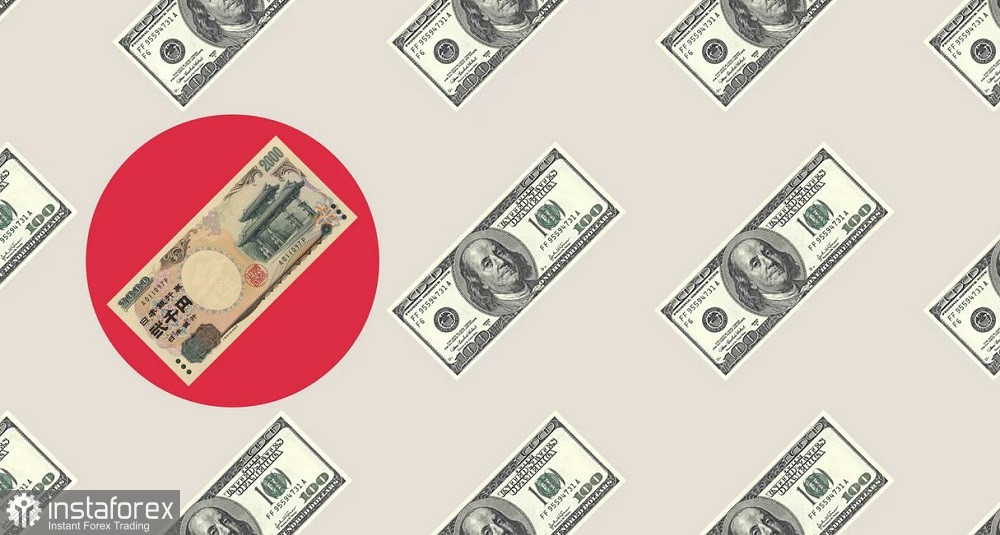The USD/JPY pair was racing towards the 152 figure. The outcome of the Bank of Japan's March meeting did not help the Japanese currency: traders were disappointed by the dovish interest rate hike, the tone of the accompanying statement, and Ueda's stance. In fact, the pair was actively rising even before the meeting, but after the BOJ announced its decision, USD/JPY buyers charged ahead, setting new local price highs.

The price will likely approach the previous peak at 151.96, which was recorded in October 2022. This mark had previously led to currency interventions by Japanese authorities in the market. The pair is in dangerous territory, playing on the nerves of the Japanese government. Such games are fraught with consequences: it's enough to remember the aforementioned year (2022) when the pair instantly dropped by 300 points in response to currency intervention, and then over the next three months, it dropped by another 2,000 points. Therefore, playing with the 151 level (let alone 152) is dangerous. It's like playing with fire. In this case, it is advisable to wait for a bearish retracement before you decide to enter long positions. For instance, if the Federal Reserve disappoints the dollar bulls and maintains its dot plot in its previous (December) form, the pair may retreat by 100-200 points, allowing USD/JPY buyers to "work" with long positions.
Take note that this week, at the end of a two-day meeting, the BOJ finally abandoned the negative interest rate policy, which it had maintained for eight years. On the one hand, this is a shift for the conservative BOJ. On the other hand, this decision was widely expected, especially after the initial results of negotiations between trade unions and employers on wage increases. In addition, the market perceived the 10-point rate hike to zero as a dovish decision: too cautious as they say.
Commenting on the results of the March meeting, BOJ Governor Kazuo Ueda stressed that he is not thinking of sudden rate hikes. And although the central bank chief theoretically allowed for such a development (the Bank will consider raising short-term rates if inflation increases), he did not specify the likely pace and timing of further tightening of monetary policy. At the same time, he voiced one significant phrase – that the central bank is not confident that wages at small and medium-sized enterprises will increase.
Take note that only one stage of the wage negotiation process has been completed so far – with the largest corporations. Major Japanese companies have decided to increase wages for their employees by an average of more than 4%, and this has allowed the BOJ to make progress. However, two more stages of negotiations lie ahead. According to the UBS Group, the extent of the "shunto" influence on small and medium-sized companies will become evident only after the second and third rounds of negotiations, which will take place on March 22 and April 4, respectively. The second round is the most important because it covers more than half of the total number of companies. If this part of the negotiation process fails, the BOJ will likely pause at least until the spring of 2025, until the next "shunto" (assuming inflation does not accelerate during this year).
Overall, according to some experts, if inflationary indicators do not surge, the central bank will keep the rate at the current level at least until the end of the first quarter of 2025.
This indicates that, despite the hawkish decision, the difference in interest rates between the Japanese central bank and the Federal Reserve is likely to decrease, but only marginally. This circumstance will continue to weigh on the yen. In addition, the Japanese currency is currently getting weaker amid lower yields on government bonds compared to other developed countries.
From a technical perspective, the USD/JPY pair on all "higher" timeframes is between the middle and upper lines of the Bollinger Bands indicator and above all lines of the Ichimoku indicator (including the Kumo cloud). All technical signals point to long positions – at least towards the 152.10 level (upper Bollinger Bands line on the 1D timeframe). However! Talking about long positions at such extremely high price levels (where the risk of currency intervention increases with every point), is quite risky. Currently, it is advisable to take a wait-and-see position and wait for a corrective pullback (ideally below the 150.00 level) to enter longs at a safer price range.
 English
English 
 Русский
Русский Bahasa Indonesia
Bahasa Indonesia Bahasa Malay
Bahasa Malay ไทย
ไทย Español
Español Deutsch
Deutsch Български
Български Français
Français Tiếng Việt
Tiếng Việt 中文
中文 বাংলা
বাংলা हिन्दी
हिन्दी Čeština
Čeština Українська
Українська Română
Română

